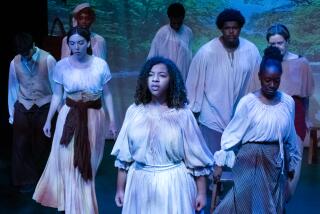Pain and Prejudice : Player Finds ‘Color Game,’ Meant to Fight Racism, Far Too Real
- Share via
Ray Otero didn’t know what he was getting into.
Ten years ago, the sociology instructor at Occidental College developed an innovative approach to teaching about racism through a role-playing exercise he called “The Color Game.”
Six years later, a documentary on the game produced by a Los Angeles television station won an Emmy and four years after that, a “CBS Schoolbreak Special” based on the game aired nationally. But now Otero--and the very premise of his controversial sociological experiment--are under attack.
Gabrielle Sanchez-Goyen, a 13-year-old junior at Holy Family High School in Glendale, was asked to play a version of the game as part of a social justice class last November. In December, after playing the game for one day, she filed a $2.1-million lawsuit against the parochial school and the Los Angeles Archdiocese, claiming emotional damage. This week, spurred by reports that Otero closely advised the high school teacher who taught the game, an attorney for the Sanchez-Goyen family said they will name the professor as a defendant in the suit as well.
Otero, a mild-mannered native of Puerto Rico with an almost missionary zeal for improving relations between the races, seems perplexed by all the fuss.
“I have no complaints about ‘The Color Game,’ except this one time, this one day,” Otero said. “It’s so unfair. Judging the game by playing for one day is like judging a book by reading the first page.”
The lawsuit has forced Otero to try to control what has become a potentially damaging phenomenon which seems to have a life of its own.
“The Color Game” involves assigning students to one of four rigidly defined social classes, with the lower classes expected to kowtow to the upper classes. Participants are chosen arbitrarily to wear armbands of different colors: orange, light green, dark green and blue. The color of armband determines the quality of life.
‘Police’ Enforce Rules
Student “police” are named to enforce the rules of the game by assigning demerits, publicly ridiculing the lower classes and other demeaning acts. At Occidental, participants play 24 hours a day for eight weeks. For years the class--one of the most popular at the 1,500-student liberal arts college--has been consistently oversubscribed.
Otero says the point of the game is to make participants realize the absurdity of judging others based solely on their external labels or characteristics by living through such experiences themselves.
Since the game first received notice, it has become more and more widely used outside Occidental College. Otero has held a copyright on the game since 1981, but that has not stopped teachers all over the country from improvising on his idea, he said. Under the intellectual property law, there is little that he, or anyone else who develops an academic tool like his, can do to stop people from modifying it.
“If his ideas are broadcast, the public is free to run with them any which way they want to,” said Paul Supnik, a Beverly Hills attorney who specializes in copyright law. “The only way to stop people is if they are using his name in connection with it.”
Otero said he does not know how many schools are using some variation of his game. And, he said, there is probably no way for him to find out. Hundreds of teachers from as far away as Singapore have written him about the game, he said, and he has given them free advice on playing it. Now, in light of the lawsuit, he said he is worried, and will think twice before giving such advice again.
‘Frustration Incredible’
“The frustration is incredible; it has just become an endless pit,’ Otero said. “But the lawsuit has magnified the need to try to find out who’s using the game.”
Otero plans to write a comprehensive manual for using the game and said he will insist teachers who contact him about the game read the manual and speak to him before using the technique. He and a business associate, Bruce Auerbach, have been peddling the idea to corporations, hoping for private sponsorship of the manual.
But Howard E. Freeman, chair of the UCLA sociology department, said there is little the inventor of any innovative sociological technique can do to control its use.
“There is no way the inventor of this type of approach, assuming he is responsible about how he initially presents this thing, can really control its dissemination,” Freeman said.
Otero says he is the victim of a system without adequate controls, but in the case of the game as it was played at Holy Family, the attorney for the Sanchez-Goyens and sociologists not involved in the case say Otero did not exert enough control over the situation.
Sought Otero’s Assistance
Holy Family teacher Louis Rodriguez, a 23-year-old former Occidental student who had never taken Otero’s class, sought the adjunct professor’s counsel when he first considered having his students play the game. By Otero’s own account, they twice met to go over the parameters of the game and Otero once spoke to the high school class about it. But it was not until Otero’s involvement had ceased and the game was actually under way, he said, that the trouble began.
At Holy Family, playing the game was mandatory for students in the class. Sanchez-Goyen, an “A” student who skipped three grades, drew the lowest color--orange. After one day of play, she quit the game. Soon after, she left the school and soon after that, she and her parents filed suit.
Looking back on his involvement at Holy Family, Otero acknowledges he may have made a serious mistake.
“If I had it to do over again, I would insist that it not be mandatory, that it be an elective,” Otero said. “I would have insisted them bringing me into the classroom, and whenever a problem would occur, talking to me about it so I could perhaps address it. The moment you let someone else who doesn’t know the game do it, you take a risk, because there are going to be extemporaneous problems in its course. If you have people who don’t know what they’re doing, certainly it can be volatile, even harmful.”
Other Techniques Involved
Besides the game, Otero’s Sociology 20 course uses lectures, guest speakers, articles, films and books covering a range of minority experiences. Otero and a trained psychologist offer counseling to students involved in the exercise and students are constantly reminded of the purpose of the game, Otero said.
“You still go out throughout your own life the way you normally do, but there’s this extra thing that changes,” said Luke Mazorra, a senior at Occidental who played the game last year. “It’s kind of like being on another planet. Your realities change.”
Despite the copyright Otero has on his game, role-playing sociological exercises like his are nothing new. First developed by psychoanalyst Jacob L. Moreno in the 1930s, socio-dramas, or psychodramas as they have previously been called, are common in socio-analytic circles.
But playing the game with an instructor who is not a sociologist or a counselor, and playing it in school, is controversial.
“Usually this is done by people who either have some experience or are very sensitive to the downside of doing this as well as the upside,” Freeman said. “If it was my kid in school, I would be concerned with what the training and the experience are of the person leading the group. It becomes the same kind of question of who you let be your therapist.”
Making the game mandatory, Freeman said, is also a mistake.
“I don’t think anybody should be coerced into doing things that really challenge their psyche unless there’s a truly compelling reason,” he said. “You’re dealing with the private emotional images in someone’s head, and they have to be ready and willing to do that.”
Despite the controversy surrounding the suit, Otero said he will continue to teach the course at Occidental and to help other teachers to play the game.
“Life is trauma,” Otero said. “Racism is trauma. Rape is trauma. Homelessness is trauma. Kids have to learn to face it. There has to be a point in growing up. There has to be a point--with limitations--but there has to be that point.”


